A Detailed Analysis: The Creation and Evolution of the Internet
VerifiedAdded on 2023/06/04

The Creation of the Internet
Name of the Student:
Name of the University:
Author Note:
Paraphrase This Document
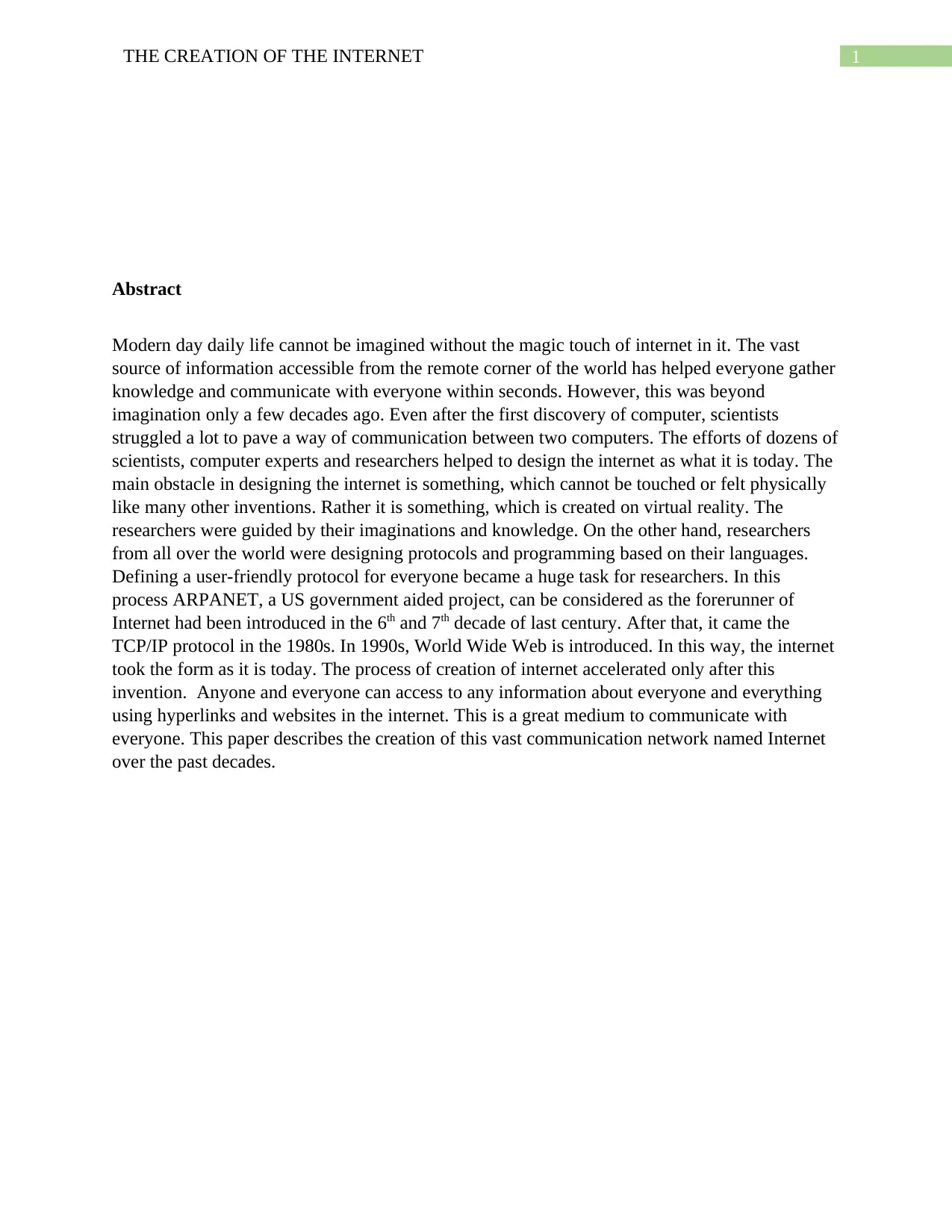
Abstract
Modern day daily life cannot be imagined without the magic touch of internet in it. The vast
source of information accessible from the remote corner of the world has helped everyone gather
knowledge and communicate with everyone within seconds. However, this was beyond
imagination only a few decades ago. Even after the first discovery of computer, scientists
struggled a lot to pave a way of communication between two computers. The efforts of dozens of
scientists, computer experts and researchers helped to design the internet as what it is today. The
main obstacle in designing the internet is something, which cannot be touched or felt physically
like many other inventions. Rather it is something, which is created on virtual reality. The
researchers were guided by their imaginations and knowledge. On the other hand, researchers
from all over the world were designing protocols and programming based on their languages.
Defining a user-friendly protocol for everyone became a huge task for researchers. In this
process ARPANET, a US government aided project, can be considered as the forerunner of
Internet had been introduced in the 6th and 7th decade of last century. After that, it came the
TCP/IP protocol in the 1980s. In 1990s, World Wide Web is introduced. In this way, the internet
took the form as it is today. The process of creation of internet accelerated only after this
invention. Anyone and everyone can access to any information about everyone and everything
using hyperlinks and websites in the internet. This is a great medium to communicate with
everyone. This paper describes the creation of this vast communication network named Internet
over the past decades.
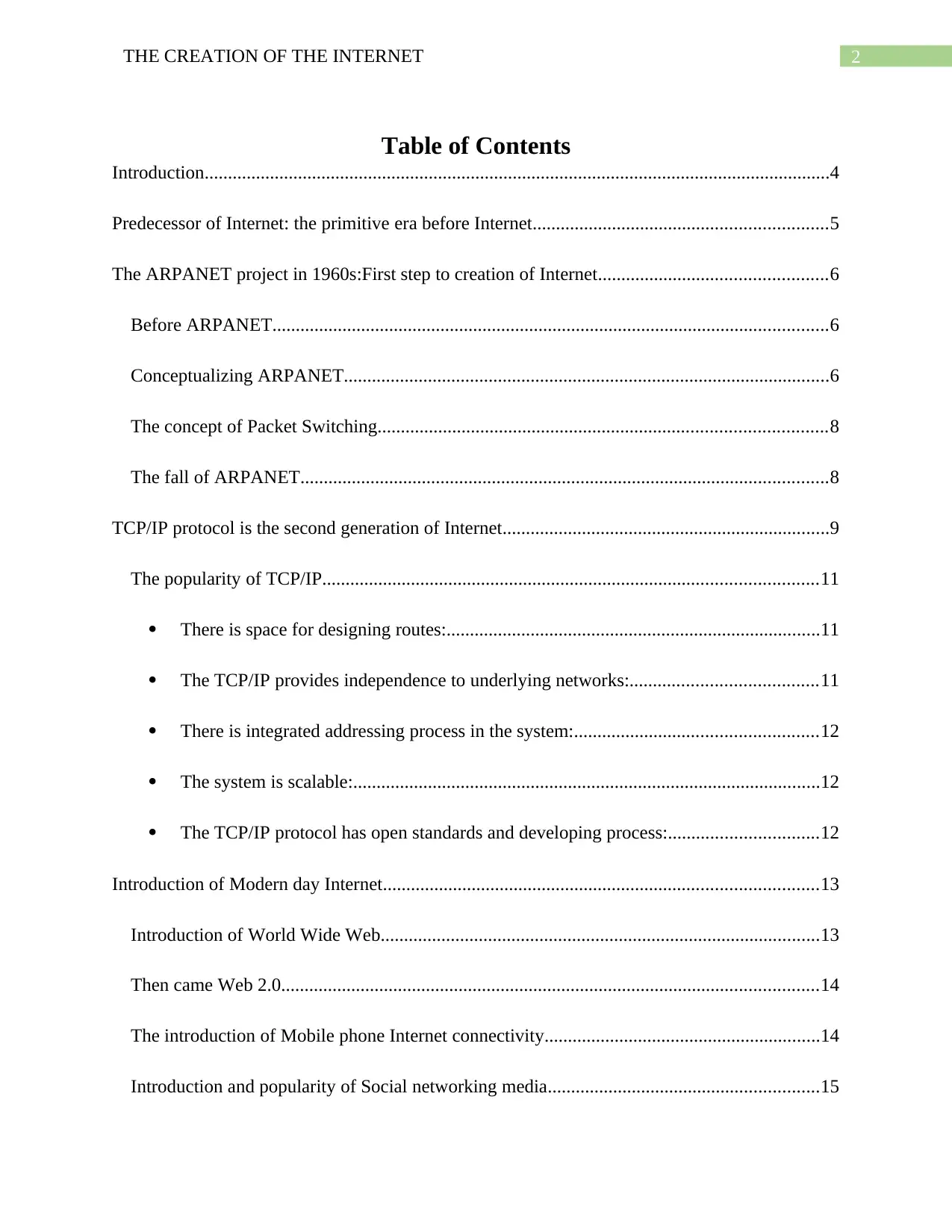
Table of Contents
Introduction......................................................................................................................................4
Predecessor of Internet: the primitive era before Internet...............................................................5
The ARPANET project in 1960s:First step to creation of Internet.................................................6
Before ARPANET.......................................................................................................................6
Conceptualizing ARPANET........................................................................................................6
The concept of Packet Switching................................................................................................8
The fall of ARPANET.................................................................................................................8
TCP/IP protocol is the second generation of Internet......................................................................9
The popularity of TCP/IP..........................................................................................................11
There is space for designing routes:................................................................................11
The TCP/IP provides independence to underlying networks:........................................11
There is integrated addressing process in the system:....................................................12
The system is scalable:....................................................................................................12
The TCP/IP protocol has open standards and developing process:................................12
Introduction of Modern day Internet.............................................................................................13
Introduction of World Wide Web..............................................................................................13
Then came Web 2.0...................................................................................................................14
The introduction of Mobile phone Internet connectivity...........................................................14
Introduction and popularity of Social networking media..........................................................15
⊘ This is a preview!⊘
Do you want full access?
Subscribe today to unlock all pages.

Trusted by 1+ million students worldwide

The introduction of Internet-of-Things for better communication............................................17
Conclusion.....................................................................................................................................17
References......................................................................................................................................18
Paraphrase This Document
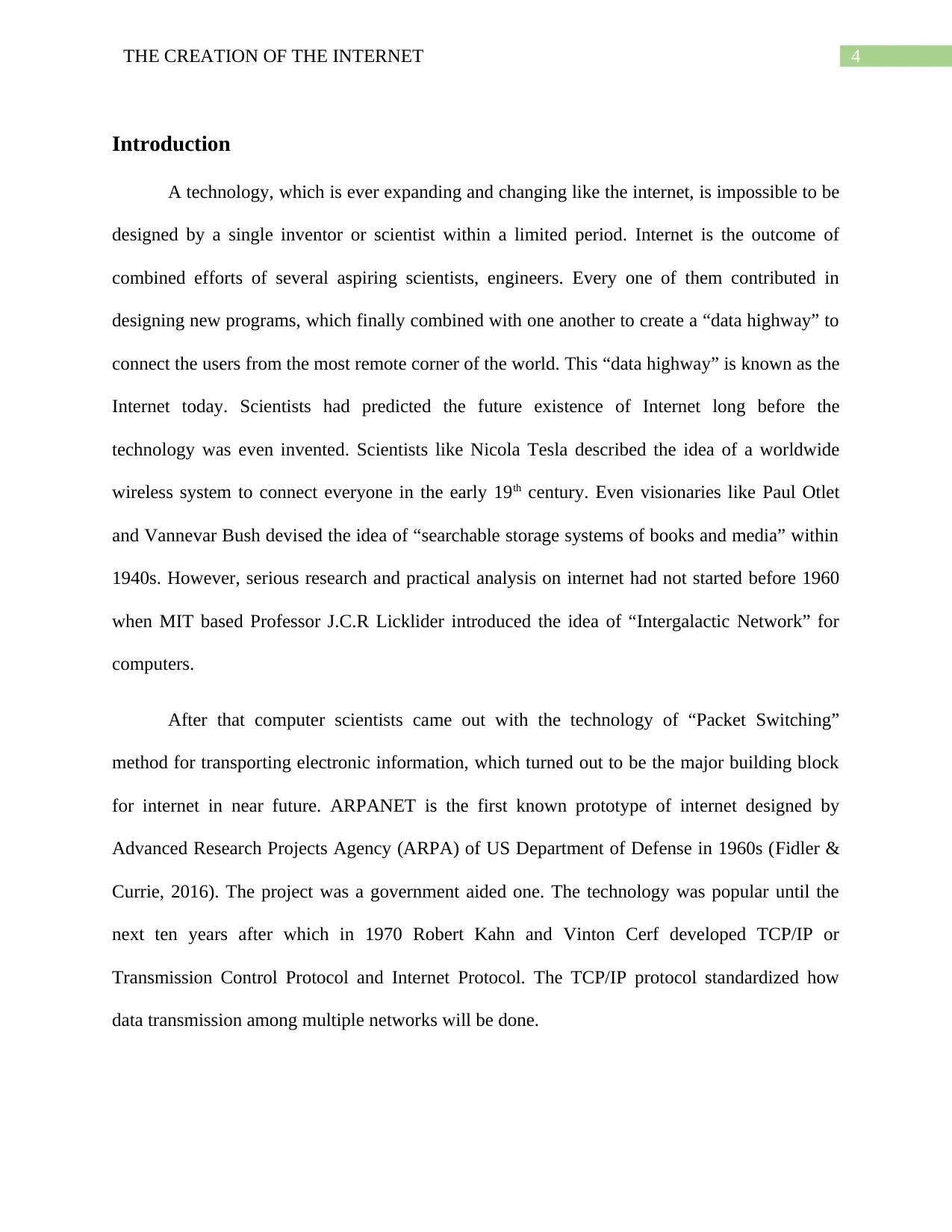
Introduction
A technology, which is ever expanding and changing like the internet, is impossible to be
designed by a single inventor or scientist within a limited period. Internet is the outcome of
combined efforts of several aspiring scientists, engineers. Every one of them contributed in
designing new programs, which finally combined with one another to create a “data highway” to
connect the users from the most remote corner of the world. This “data highway” is known as the
Internet today. Scientists had predicted the future existence of Internet long before the
technology was even invented. Scientists like Nicola Tesla described the idea of a worldwide
wireless system to connect everyone in the early 19th century. Even visionaries like Paul Otlet
and Vannevar Bush devised the idea of “searchable storage systems of books and media” within
1940s. However, serious research and practical analysis on internet had not started before 1960
when MIT based Professor J.C.R Licklider introduced the idea of “Intergalactic Network” for
computers.
After that computer scientists came out with the technology of “Packet Switching”
method for transporting electronic information, which turned out to be the major building block
for internet in near future. ARPANET is the first known prototype of internet designed by
Advanced Research Projects Agency (ARPA) of US Department of Defense in 1960s (Fidler &
Currie, 2016). The project was a government aided one. The technology was popular until the
next ten years after which in 1970 Robert Kahn and Vinton Cerf developed TCP/IP or
Transmission Control Protocol and Internet Protocol. The TCP/IP protocol standardized how
data transmission among multiple networks will be done.
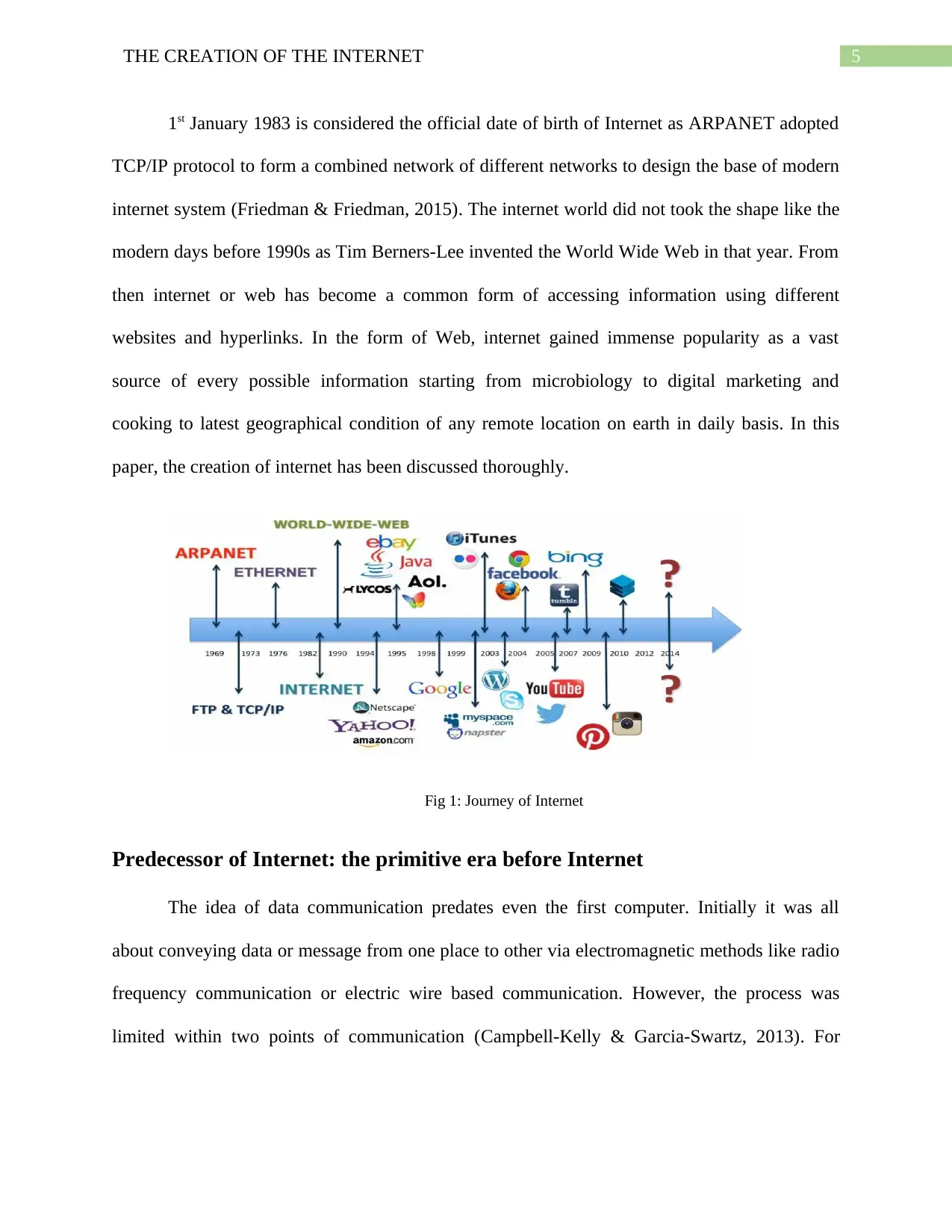
1st January 1983 is considered the official date of birth of Internet as ARPANET adopted
TCP/IP protocol to form a combined network of different networks to design the base of modern
internet system (Friedman & Friedman, 2015). The internet world did not took the shape like the
modern days before 1990s as Tim Berners-Lee invented the World Wide Web in that year. From
then internet or web has become a common form of accessing information using different
websites and hyperlinks. In the form of Web, internet gained immense popularity as a vast
source of every possible information starting from microbiology to digital marketing and
cooking to latest geographical condition of any remote location on earth in daily basis. In this
paper, the creation of internet has been discussed thoroughly.
Fig 1: Journey of Internet
Predecessor of Internet: the primitive era before Internet
The idea of data communication predates even the first computer. Initially it was all
about conveying data or message from one place to other via electromagnetic methods like radio
frequency communication or electric wire based communication. However, the process was
limited within two points of communication (Campbell-Kelly & Garcia-Swartz, 2013). For
⊘ This is a preview!⊘
Do you want full access?
Subscribe today to unlock all pages.

Trusted by 1+ million students worldwide
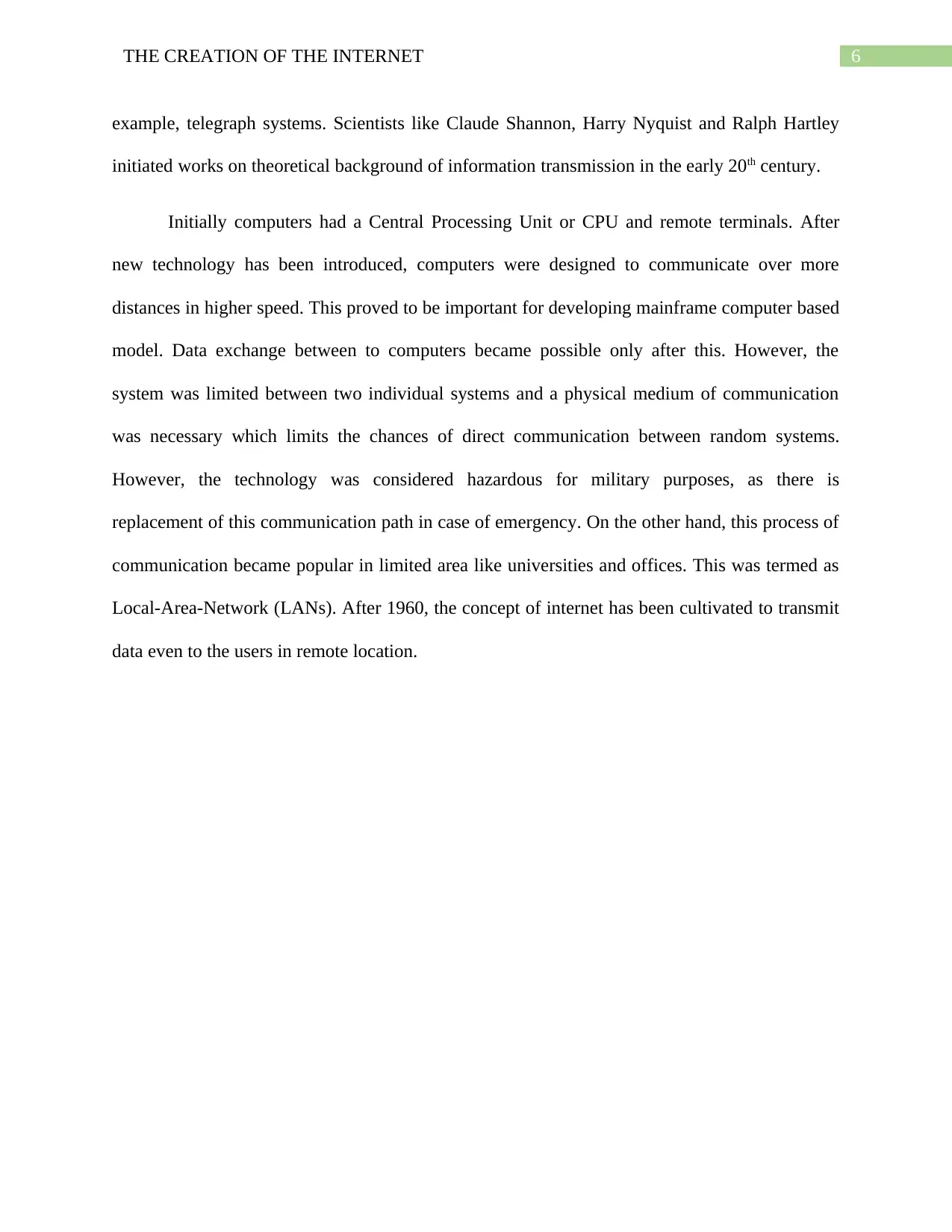
example, telegraph systems. Scientists like Claude Shannon, Harry Nyquist and Ralph Hartley
initiated works on theoretical background of information transmission in the early 20th century.
Initially computers had a Central Processing Unit or CPU and remote terminals. After
new technology has been introduced, computers were designed to communicate over more
distances in higher speed. This proved to be important for developing mainframe computer based
model. Data exchange between to computers became possible only after this. However, the
system was limited between two individual systems and a physical medium of communication
was necessary which limits the chances of direct communication between random systems.
However, the technology was considered hazardous for military purposes, as there is
replacement of this communication path in case of emergency. On the other hand, this process of
communication became popular in limited area like universities and offices. This was termed as
Local-Area-Network (LANs). After 1960, the concept of internet has been cultivated to transmit
data even to the users in remote location.
Paraphrase This Document
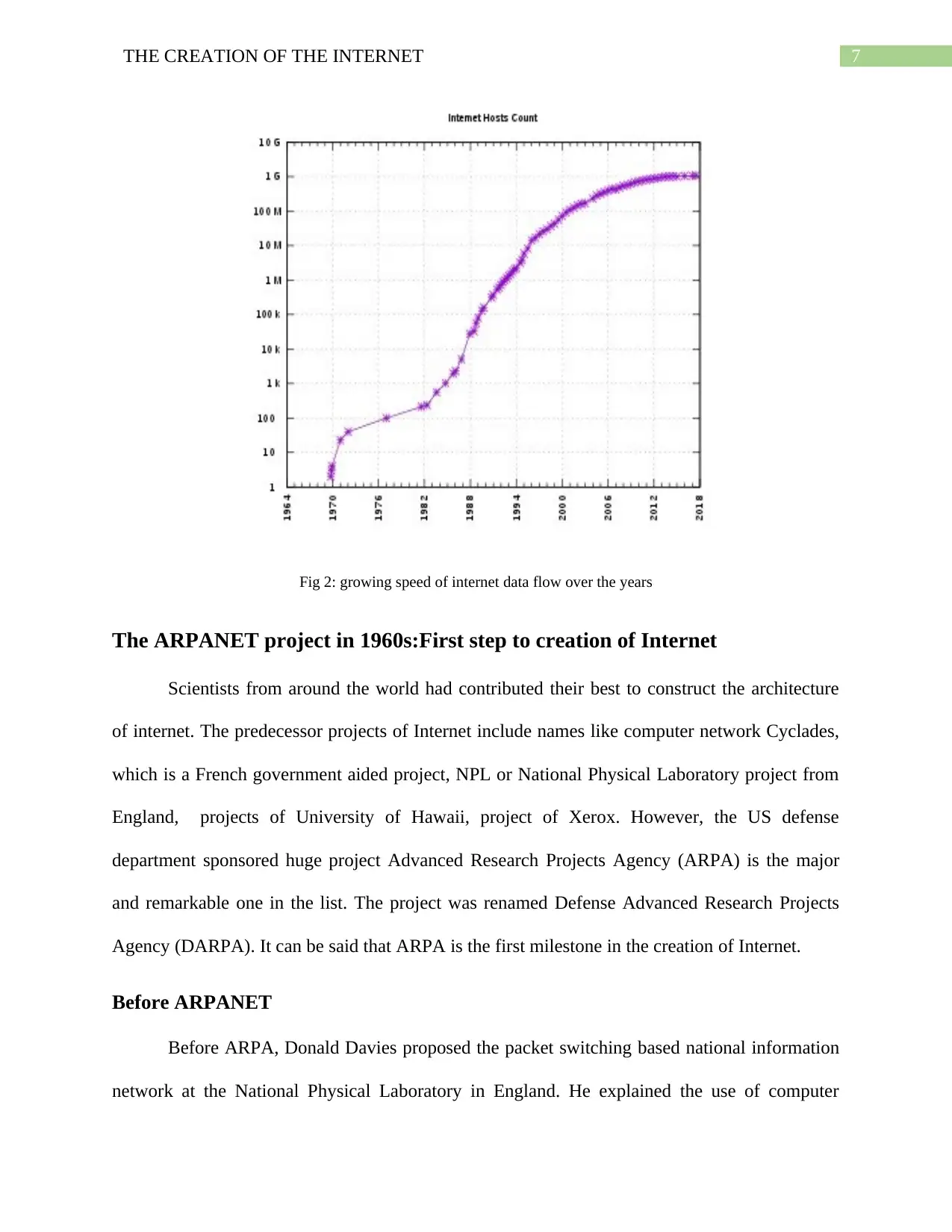
Fig 2: growing speed of internet data flow over the years
The ARPANET project in 1960s:First step to creation of Internet
Scientists from around the world had contributed their best to construct the architecture
of internet. The predecessor projects of Internet include names like computer network Cyclades,
which is a French government aided project, NPL or National Physical Laboratory project from
England, projects of University of Hawaii, project of Xerox. However, the US defense
department sponsored huge project Advanced Research Projects Agency (ARPA) is the major
and remarkable one in the list. The project was renamed Defense Advanced Research Projects
Agency (DARPA). It can be said that ARPA is the first milestone in the creation of Internet.
Before ARPANET
Before ARPA, Donald Davies proposed the packet switching based national information
network at the National Physical Laboratory in England. He explained the use of computer
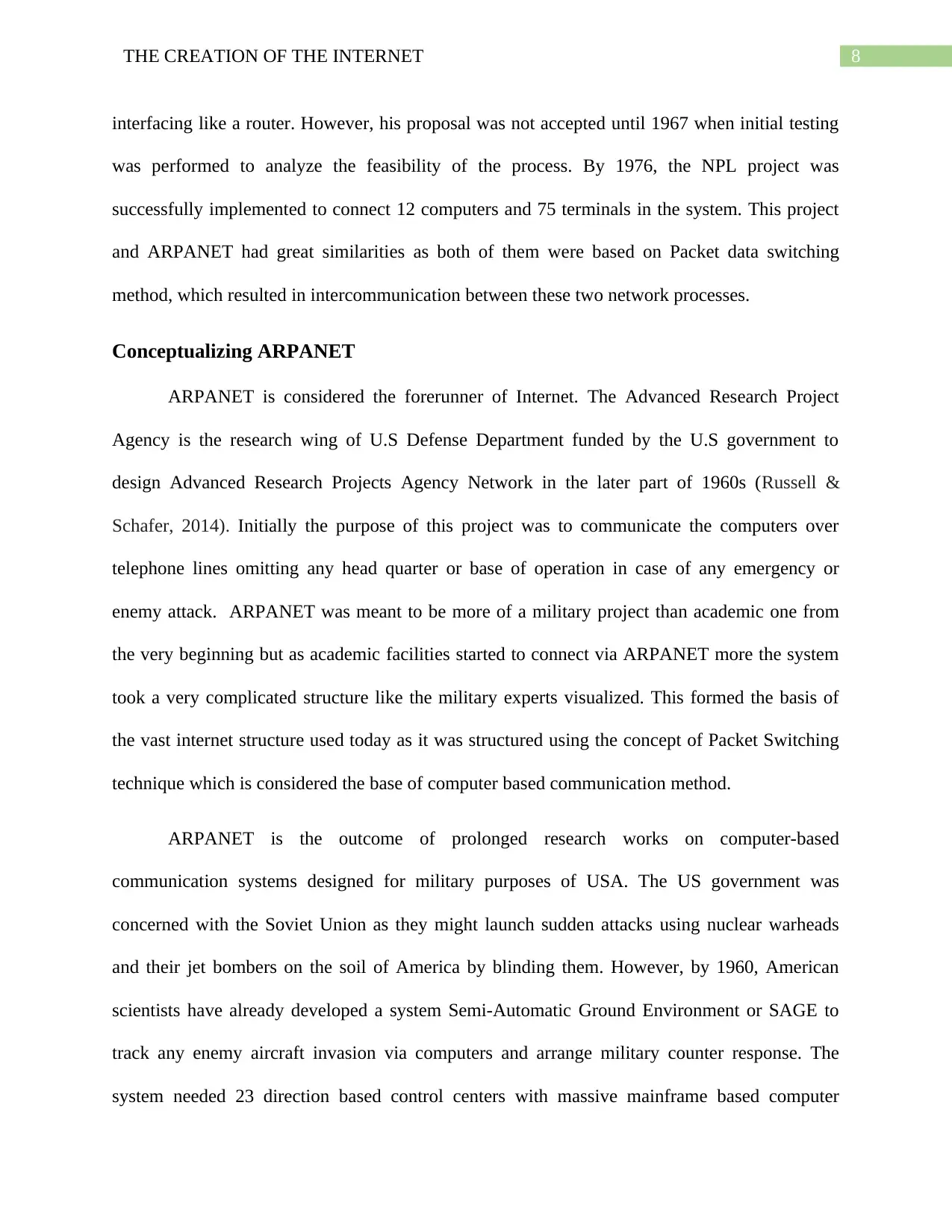
interfacing like a router. However, his proposal was not accepted until 1967 when initial testing
was performed to analyze the feasibility of the process. By 1976, the NPL project was
successfully implemented to connect 12 computers and 75 terminals in the system. This project
and ARPANET had great similarities as both of them were based on Packet data switching
method, which resulted in intercommunication between these two network processes.
Conceptualizing ARPANET
ARPANET is considered the forerunner of Internet. The Advanced Research Project
Agency is the research wing of U.S Defense Department funded by the U.S government to
design Advanced Research Projects Agency Network in the later part of 1960s (Russell &
Schafer, 2014). Initially the purpose of this project was to communicate the computers over
telephone lines omitting any head quarter or base of operation in case of any emergency or
enemy attack. ARPANET was meant to be more of a military project than academic one from
the very beginning but as academic facilities started to connect via ARPANET more the system
took a very complicated structure like the military experts visualized. This formed the basis of
the vast internet structure used today as it was structured using the concept of Packet Switching
technique which is considered the base of computer based communication method.
ARPANET is the outcome of prolonged research works on computer-based
communication systems designed for military purposes of USA. The US government was
concerned with the Soviet Union as they might launch sudden attacks using nuclear warheads
and their jet bombers on the soil of America by blinding them. However, by 1960, American
scientists have already developed a system Semi-Automatic Ground Environment or SAGE to
track any enemy aircraft invasion via computers and arrange military counter response. The
system needed 23 direction based control centers with massive mainframe based computer
⊘ This is a preview!⊘
Do you want full access?
Subscribe today to unlock all pages.

Trusted by 1+ million students worldwide

systems to track 400 aircrafts simultaneously and differentiate the enemy planes and allied ones.
This vast system was designed on the cost of more than $60 billion and six years of immense
hard work of experts. The system was unique in terms of human-machine interface. Experts of
that era praised the invention. Eventually scientists like Robnett Licklidder, Robert Taylor had
joined the ARPA project of US Defense Department in Pentagon and proposed a generalized
protocol for all the computer facility there. On basis of their recommendation, pentagon called
out for 16 universities and research facilities authorized by Pentagon and the US Defense
Department to develop a new computer communication network ARPANET for ARPA in 1968.
By 1969, Bolt, Beranek and Newman from Cambridge, Massachusetts won the contract for $1
million. This way the two experts eventually reduced the involvement of military forces in the
invention of computer communication and indulged the researchers to develop a better solution
for scientists and students and overall common people to communicate over computer.
Fig 3: Map of ARPANET in 1969
The concept of Packet Switching
The success of ARPANET lies on the utilization of Packet Data Switching technology. It
helped ARPANET to communicate over long distance without any error and without telephonic
networks. The researchers of RAND Corporation under the leadership of Paul Baran first
Paraphrase This Document

conceptualized the idea of Packet Data Switching technology. Packets of Data are basically small
cluster like designs which break down the digital information in small parts which makes the
overall transmission convenient (Kurose, 2014). The packages are marked as per their contents
and do not follow the same path to move. In addition to this, they are not transmitted or received
in sequential way. The packets of data are secured by mathematical verification codes to make
sure the packets are delivered securely to the appropriate address. The route of transmission has
switches, which control the data flow. These switches are controlled by computers. The US
government initially ignored the theory of Packet Data switching, however, when the project of
ARPANET initiated, researchers started to consider this as the basis of building the
communication process.
Fig 4: concept of Packet Data Switching used in ARPANET
The fall of ARPANET
Initially the researchers under the leadership of Leonard Kleinrock, successfully sent
packet data from one computer to another. Initial connection had many flaws and the researchers
were able to eliminate them. Even with lots of limitations, researchers were able to perform basic
tasks via the communication route. The nodes increased to 15 nodes and 23 terminals from four
centers of initial ARPANET. By 1973, the number of terminals increased to 63. The new
protocols like File Transfer Protocol (FTP), Telnet, and Network Control Protocol (NCP) were
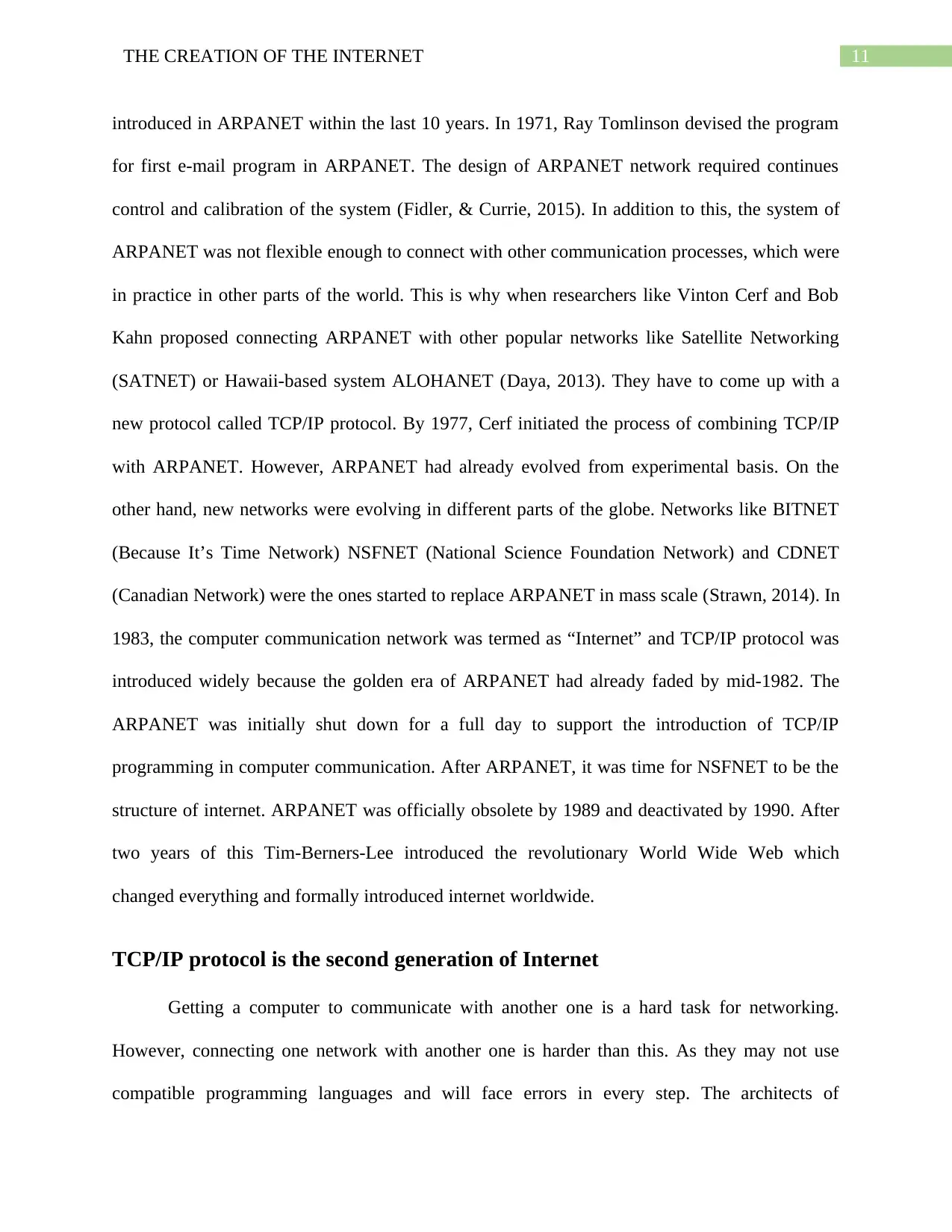
introduced in ARPANET within the last 10 years. In 1971, Ray Tomlinson devised the program
for first e-mail program in ARPANET. The design of ARPANET network required continues
control and calibration of the system (Fidler, & Currie, 2015). In addition to this, the system of
ARPANET was not flexible enough to connect with other communication processes, which were
in practice in other parts of the world. This is why when researchers like Vinton Cerf and Bob
Kahn proposed connecting ARPANET with other popular networks like Satellite Networking
(SATNET) or Hawaii-based system ALOHANET (Daya, 2013). They have to come up with a
new protocol called TCP/IP protocol. By 1977, Cerf initiated the process of combining TCP/IP
with ARPANET. However, ARPANET had already evolved from experimental basis. On the
other hand, new networks were evolving in different parts of the globe. Networks like BITNET
(Because It’s Time Network) NSFNET (National Science Foundation Network) and CDNET
(Canadian Network) were the ones started to replace ARPANET in mass scale (Strawn, 2014). In
1983, the computer communication network was termed as “Internet” and TCP/IP protocol was
introduced widely because the golden era of ARPANET had already faded by mid-1982. The
ARPANET was initially shut down for a full day to support the introduction of TCP/IP
programming in computer communication. After ARPANET, it was time for NSFNET to be the
structure of internet. ARPANET was officially obsolete by 1989 and deactivated by 1990. After
two years of this Tim-Berners-Lee introduced the revolutionary World Wide Web which
changed everything and formally introduced internet worldwide.
TCP/IP protocol is the second generation of Internet
Getting a computer to communicate with another one is a hard task for networking.
However, connecting one network with another one is harder than this. As they may not use
compatible programming languages and will face errors in every step. The architects of
⊘ This is a preview!⊘
Do you want full access?
Subscribe today to unlock all pages.

Trusted by 1+ million students worldwide

ARPANET, the forerunner of internet, where trying their best to overcome this problem and
combine ARPANET with other evolving networks. This will be helpful in information
transmission around the world. In 1974, Robert Kahn and Vinton Cerf proposed a new blueprint
of programming (Tanasic). They scrutinized all the communication over the international
networking societies happening around the globe. This way they designed a simple yet flexible
universal set of protocols to be followed in computer communication. However, the protocols
had to be balanced perfectly between security and flexibility (Haigh, Russell & Dutton, 2015).
They had to be secure enough to ensure proper delivery of messages at the same time they have
to be flexible enough to allow different pathways for data transmission. Cerf described how they
had to work hard to make the protocol ready for future expansion (Mohan, 2013). The experts
had to keep enough space for future expansions and collaborations as protocols cannot be
designed for one instance of time. This has been considered the best part of Transmission
Control Protocol/ Internet Protocol (TCP/IP).
With time, these rules have been the base of internet architecture. However, before
implement it commercially these protocols need to be modified and tested over and over again.
Without the invention of TCP/IP protocol, the internet was only a hint of imagination even with
cash flow of the US military at times of cold war.
Paraphrase This Document

Fig 5: How TCP/IP works
In the next decades many TCP/IP protocol incorporated with different networking and
protocols however, there are two primary parts of the overall protocol system. They are the
internet protocol, which defines the communication among multiple networks, and the second
one is the transmission control protocol, which defines the data transmission system.
Fig 6: Data Transmission process using TCP/IP
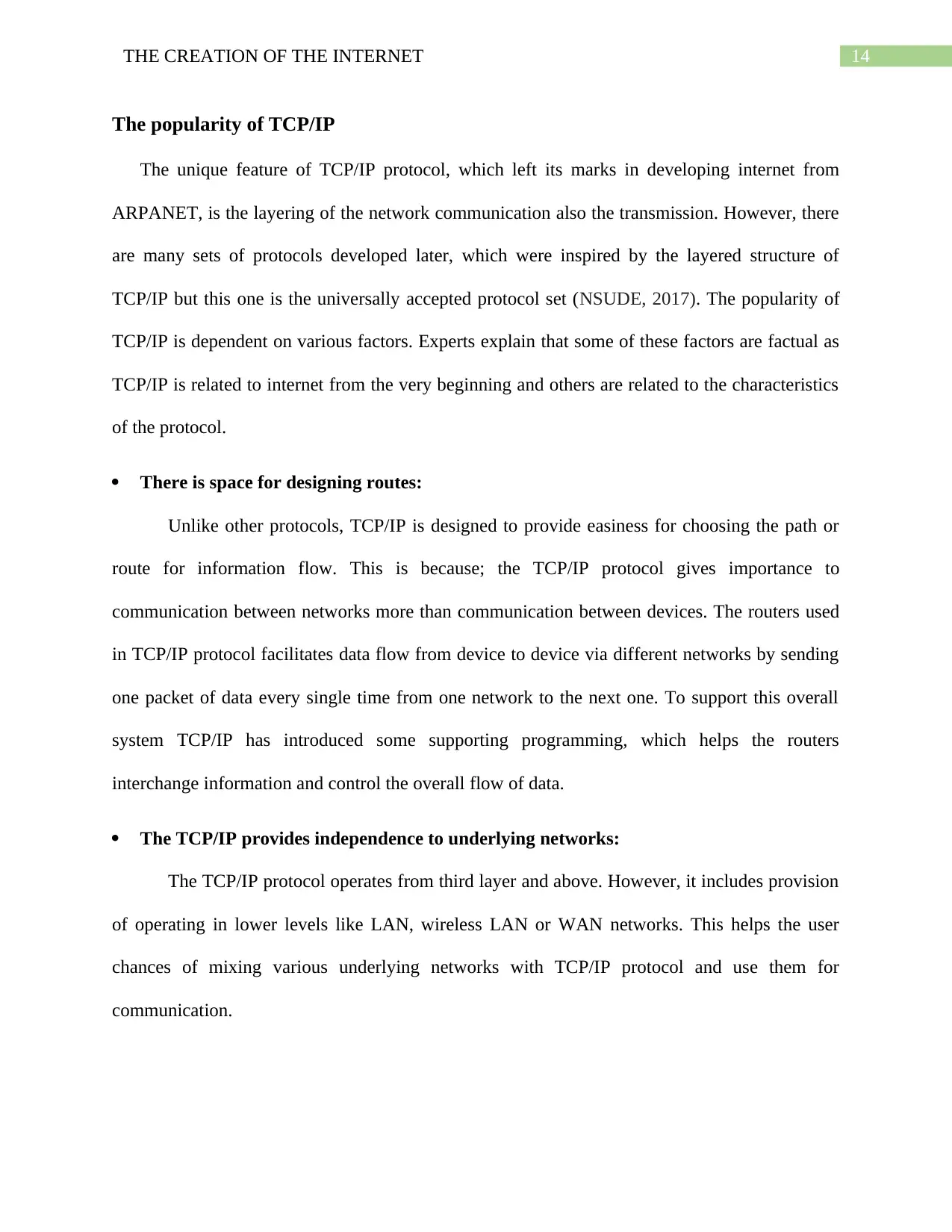
The popularity of TCP/IP
The unique feature of TCP/IP protocol, which left its marks in developing internet from
ARPANET, is the layering of the network communication also the transmission. However, there
are many sets of protocols developed later, which were inspired by the layered structure of
TCP/IP but this one is the universally accepted protocol set (NSUDE, 2017). The popularity of
TCP/IP is dependent on various factors. Experts explain that some of these factors are factual as
TCP/IP is related to internet from the very beginning and others are related to the characteristics
of the protocol.
There is space for designing routes:
Unlike other protocols, TCP/IP is designed to provide easiness for choosing the path or
route for information flow. This is because; the TCP/IP protocol gives importance to
communication between networks more than communication between devices. The routers used
in TCP/IP protocol facilitates data flow from device to device via different networks by sending
one packet of data every single time from one network to the next one. To support this overall
system TCP/IP has introduced some supporting programming, which helps the routers
interchange information and control the overall flow of data.
The TCP/IP provides independence to underlying networks:
The TCP/IP protocol operates from third layer and above. However, it includes provision
of operating in lower levels like LAN, wireless LAN or WAN networks. This helps the user
chances of mixing various underlying networks with TCP/IP protocol and use them for
communication.
⊘ This is a preview!⊘
Do you want full access?
Subscribe today to unlock all pages.

Trusted by 1+ million students worldwide
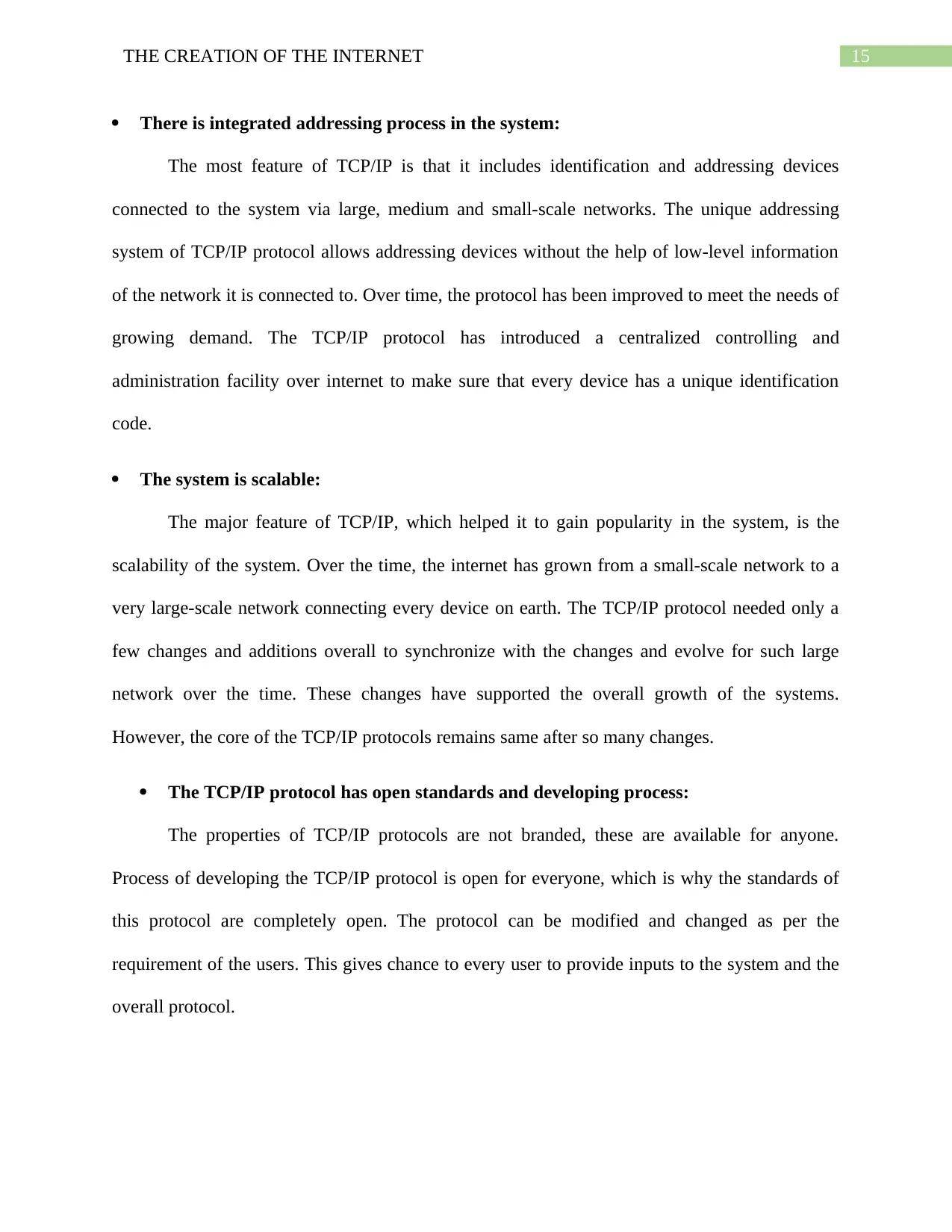
There is integrated addressing process in the system:
The most feature of TCP/IP is that it includes identification and addressing devices
connected to the system via large, medium and small-scale networks. The unique addressing
system of TCP/IP protocol allows addressing devices without the help of low-level information
of the network it is connected to. Over time, the protocol has been improved to meet the needs of
growing demand. The TCP/IP protocol has introduced a centralized controlling and
administration facility over internet to make sure that every device has a unique identification
code.
The system is scalable:
The major feature of TCP/IP, which helped it to gain popularity in the system, is the
scalability of the system. Over the time, the internet has grown from a small-scale network to a
very large-scale network connecting every device on earth. The TCP/IP protocol needed only a
few changes and additions overall to synchronize with the changes and evolve for such large
network over the time. These changes have supported the overall growth of the systems.
However, the core of the TCP/IP protocols remains same after so many changes.
The TCP/IP protocol has open standards and developing process:
The properties of TCP/IP protocols are not branded, these are available for anyone.
Process of developing the TCP/IP protocol is open for everyone, which is why the standards of
this protocol are completely open. The protocol can be modified and changed as per the
requirement of the users. This gives chance to every user to provide inputs to the system and the
overall protocol.
Paraphrase This Document
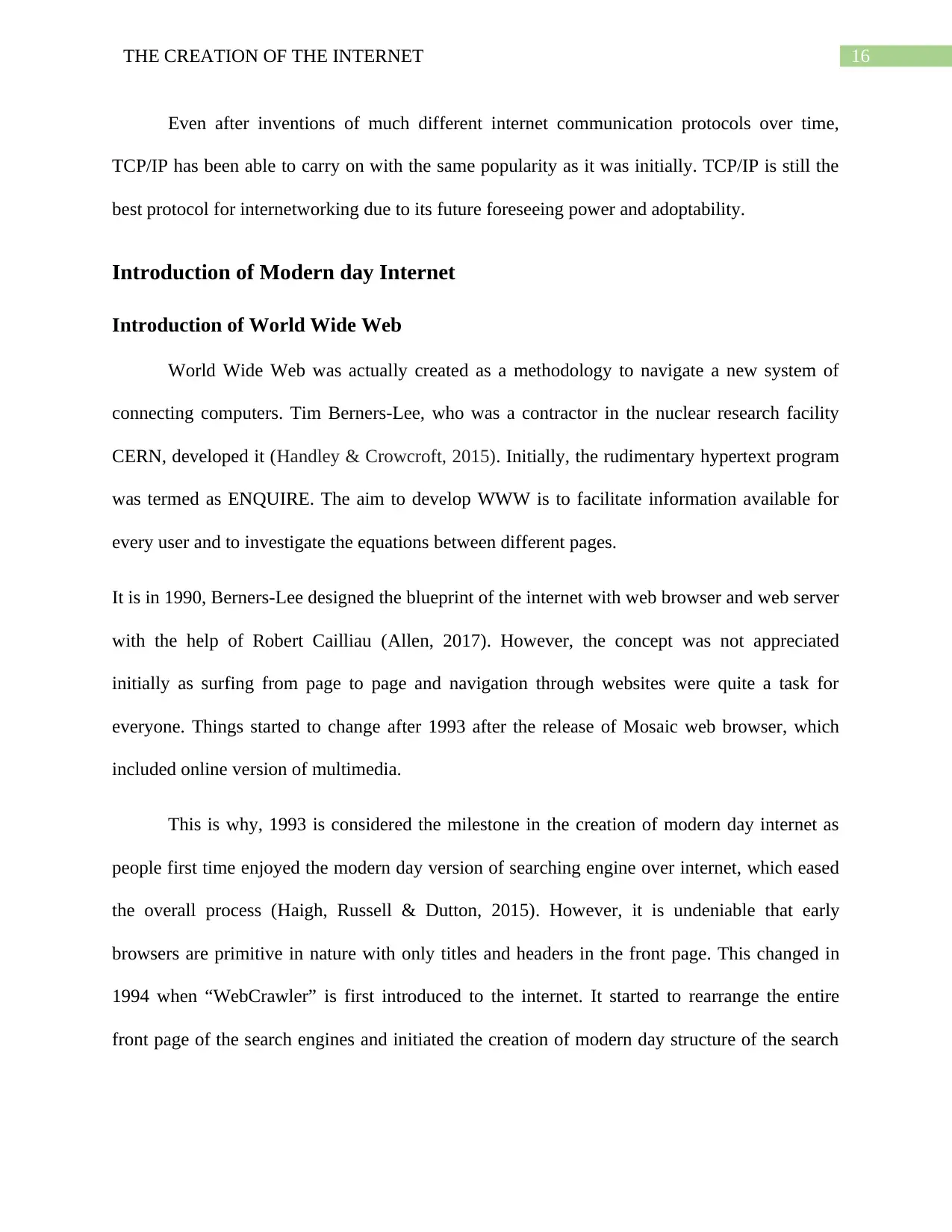
Even after inventions of much different internet communication protocols over time,
TCP/IP has been able to carry on with the same popularity as it was initially. TCP/IP is still the
best protocol for internetworking due to its future foreseeing power and adoptability.
Introduction of Modern day Internet
Introduction of World Wide Web
World Wide Web was actually created as a methodology to navigate a new system of
connecting computers. Tim Berners-Lee, who was a contractor in the nuclear research facility
CERN, developed it (Handley & Crowcroft, 2015). Initially, the rudimentary hypertext program
was termed as ENQUIRE. The aim to develop WWW is to facilitate information available for
every user and to investigate the equations between different pages.
It is in 1990, Berners-Lee designed the blueprint of the internet with web browser and web server
with the help of Robert Cailliau (Allen, 2017). However, the concept was not appreciated
initially as surfing from page to page and navigation through websites were quite a task for
everyone. Things started to change after 1993 after the release of Mosaic web browser, which
included online version of multimedia.
This is why, 1993 is considered the milestone in the creation of modern day internet as
people first time enjoyed the modern day version of searching engine over internet, which eased
the overall process (Haigh, Russell & Dutton, 2015). However, it is undeniable that early
browsers are primitive in nature with only titles and headers in the front page. This changed in
1994 when “WebCrawler” is first introduced to the internet. It started to rearrange the entire
front page of the search engines and initiated the creation of modern day structure of the search

engines. This way powerful version of search engines introduced which gradually eased the
overall process of information surfing and connecting with everyone over internet.
Besides these improvements, Berners-Lee created the World Wide Web Consortium or
W3C to help in the improvement of the search engines and ease the accessibility of the internet.
The aim of Berners-Lee was to make internet available for everyone in free of cost.
Fig 7: Chart of growth rate in World Wide Web
Then came Web 2.0
The introduction of “Dot-Com” in 1999 had a deep impact on business world. Many
people started to shift their business online. For example newspapers and magazines,
entertainment businesses, retail shops and many more. Initially, websites usually collected and
published information related to their businesses for everyone to view only. However, little did
everybody cared for the interaction between website creators and visitors to the website. The
demand of interaction with visitors increased with the improvement of internet and website. This
is when Web 2.0, more public friendly social version of internet was introduced (Allen, 2013).
⊘ This is a preview!⊘
Do you want full access?
Subscribe today to unlock all pages.

Trusted by 1+ million students worldwide
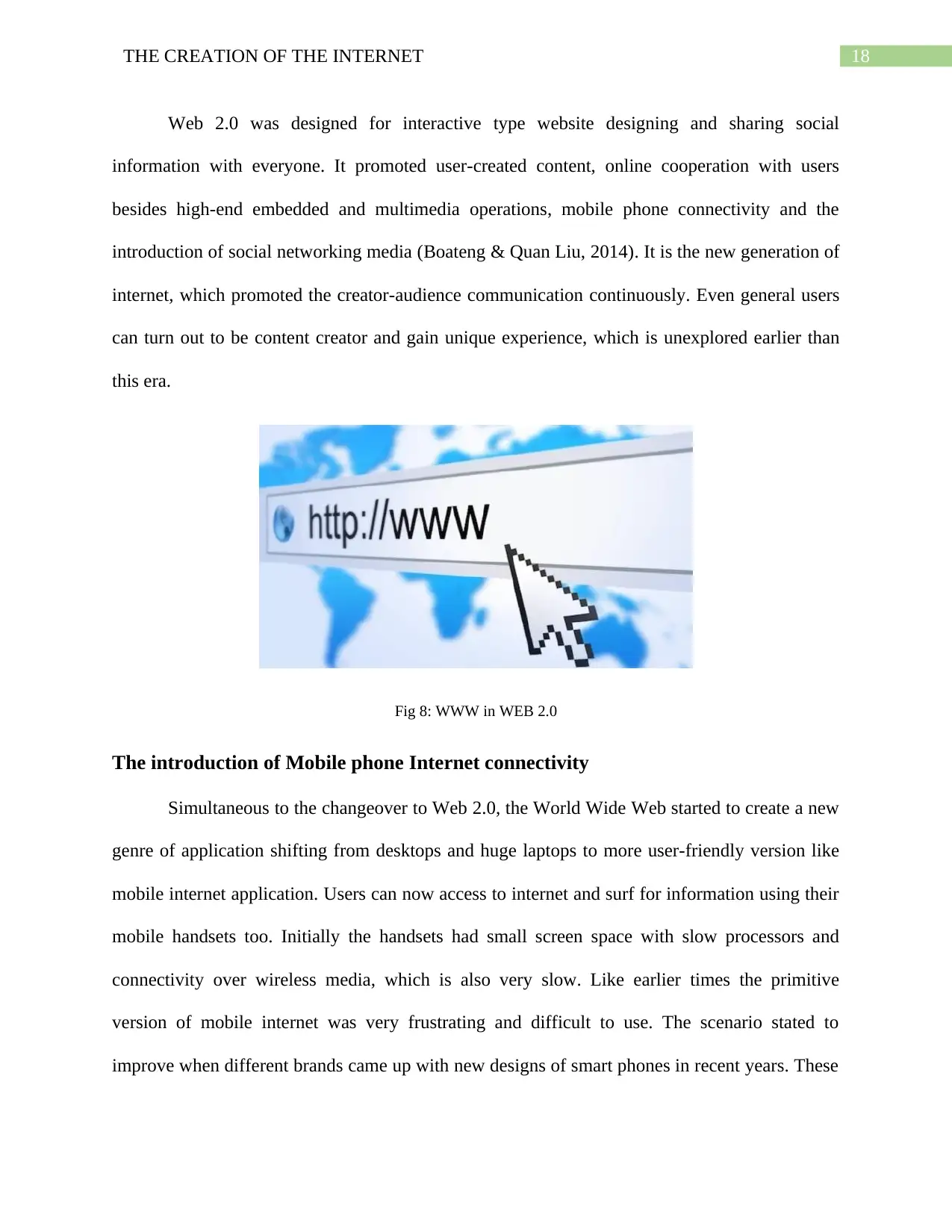
Web 2.0 was designed for interactive type website designing and sharing social
information with everyone. It promoted user-created content, online cooperation with users
besides high-end embedded and multimedia operations, mobile phone connectivity and the
introduction of social networking media (Boateng & Quan Liu, 2014). It is the new generation of
internet, which promoted the creator-audience communication continuously. Even general users
can turn out to be content creator and gain unique experience, which is unexplored earlier than
this era.
Fig 8: WWW in WEB 2.0
The introduction of Mobile phone Internet connectivity
Simultaneous to the changeover to Web 2.0, the World Wide Web started to create a new
genre of application shifting from desktops and huge laptops to more user-friendly version like
mobile internet application. Users can now access to internet and surf for information using their
mobile handsets too. Initially the handsets had small screen space with slow processors and
connectivity over wireless media, which is also very slow. Like earlier times the primitive
version of mobile internet was very frustrating and difficult to use. The scenario stated to
improve when different brands came up with new designs of smart phones in recent years. These
Paraphrase This Document
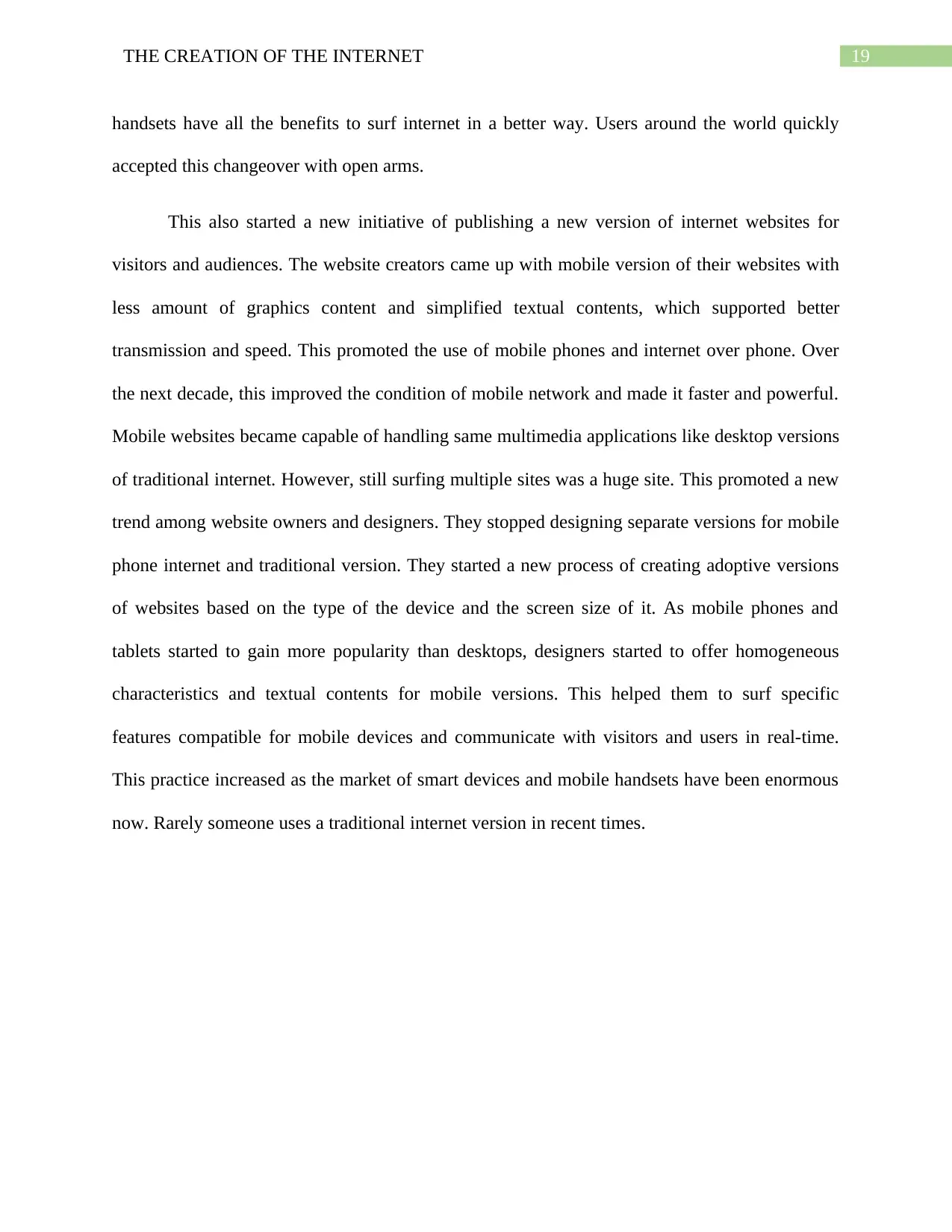
handsets have all the benefits to surf internet in a better way. Users around the world quickly
accepted this changeover with open arms.
This also started a new initiative of publishing a new version of internet websites for
visitors and audiences. The website creators came up with mobile version of their websites with
less amount of graphics content and simplified textual contents, which supported better
transmission and speed. This promoted the use of mobile phones and internet over phone. Over
the next decade, this improved the condition of mobile network and made it faster and powerful.
Mobile websites became capable of handling same multimedia applications like desktop versions
of traditional internet. However, still surfing multiple sites was a huge site. This promoted a new
trend among website owners and designers. They stopped designing separate versions for mobile
phone internet and traditional version. They started a new process of creating adoptive versions
of websites based on the type of the device and the screen size of it. As mobile phones and
tablets started to gain more popularity than desktops, designers started to offer homogeneous
characteristics and textual contents for mobile versions. This helped them to surf specific
features compatible for mobile devices and communicate with visitors and users in real-time.
This practice increased as the market of smart devices and mobile handsets have been enormous
now. Rarely someone uses a traditional internet version in recent times.
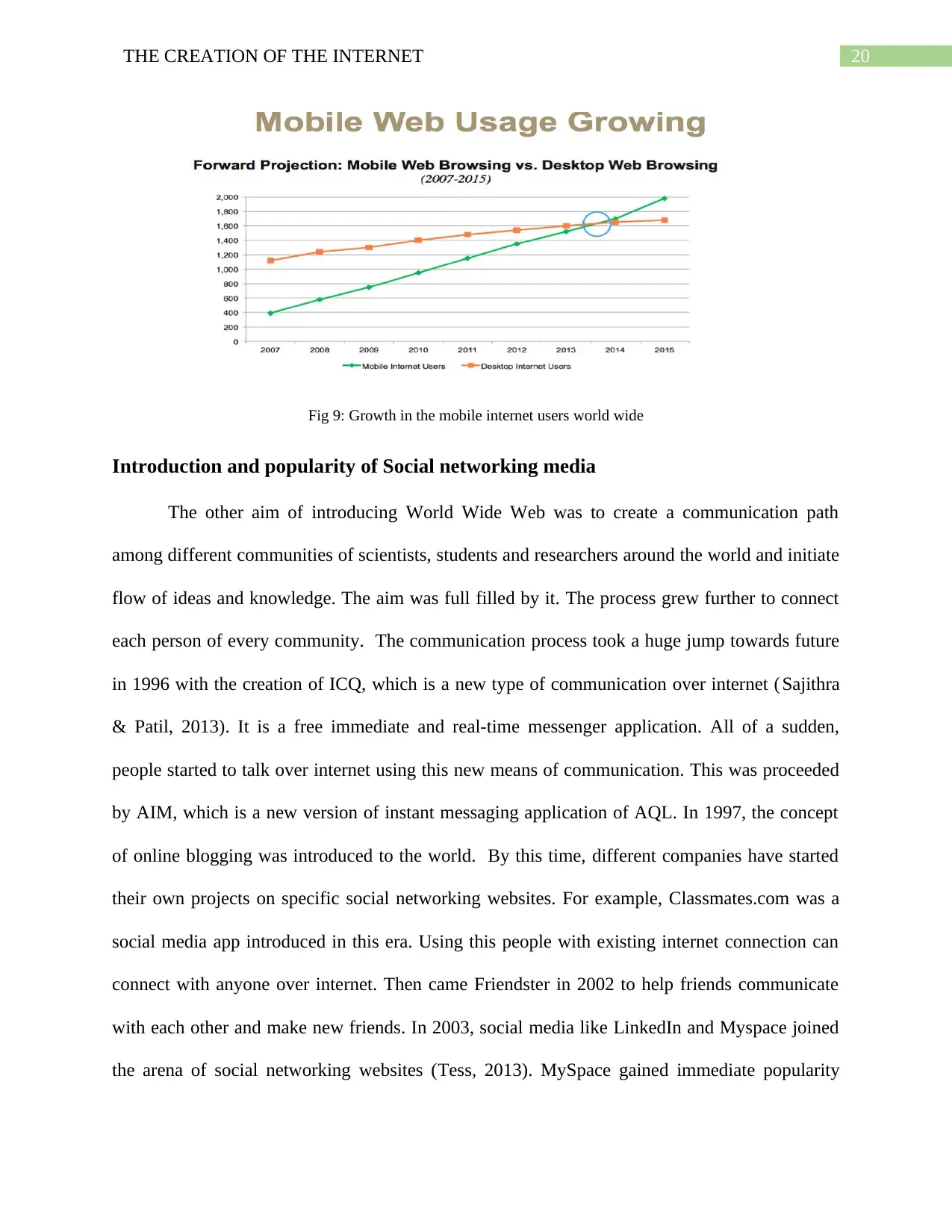
Fig 9: Growth in the mobile internet users world wide
Introduction and popularity of Social networking media
The other aim of introducing World Wide Web was to create a communication path
among different communities of scientists, students and researchers around the world and initiate
flow of ideas and knowledge. The aim was full filled by it. The process grew further to connect
each person of every community. The communication process took a huge jump towards future
in 1996 with the creation of ICQ, which is a new type of communication over internet ( Sajithra
& Patil, 2013). It is a free immediate and real-time messenger application. All of a sudden,
people started to talk over internet using this new means of communication. This was proceeded
by AIM, which is a new version of instant messaging application of AQL. In 1997, the concept
of online blogging was introduced to the world. By this time, different companies have started
their own projects on specific social networking websites. For example, Classmates.com was a
social media app introduced in this era. Using this people with existing internet connection can
connect with anyone over internet. Then came Friendster in 2002 to help friends communicate
with each other and make new friends. In 2003, social media like LinkedIn and Myspace joined
the arena of social networking websites (Tess, 2013). MySpace gained immediate popularity
⊘ This is a preview!⊘
Do you want full access?
Subscribe today to unlock all pages.

Trusted by 1+ million students worldwide
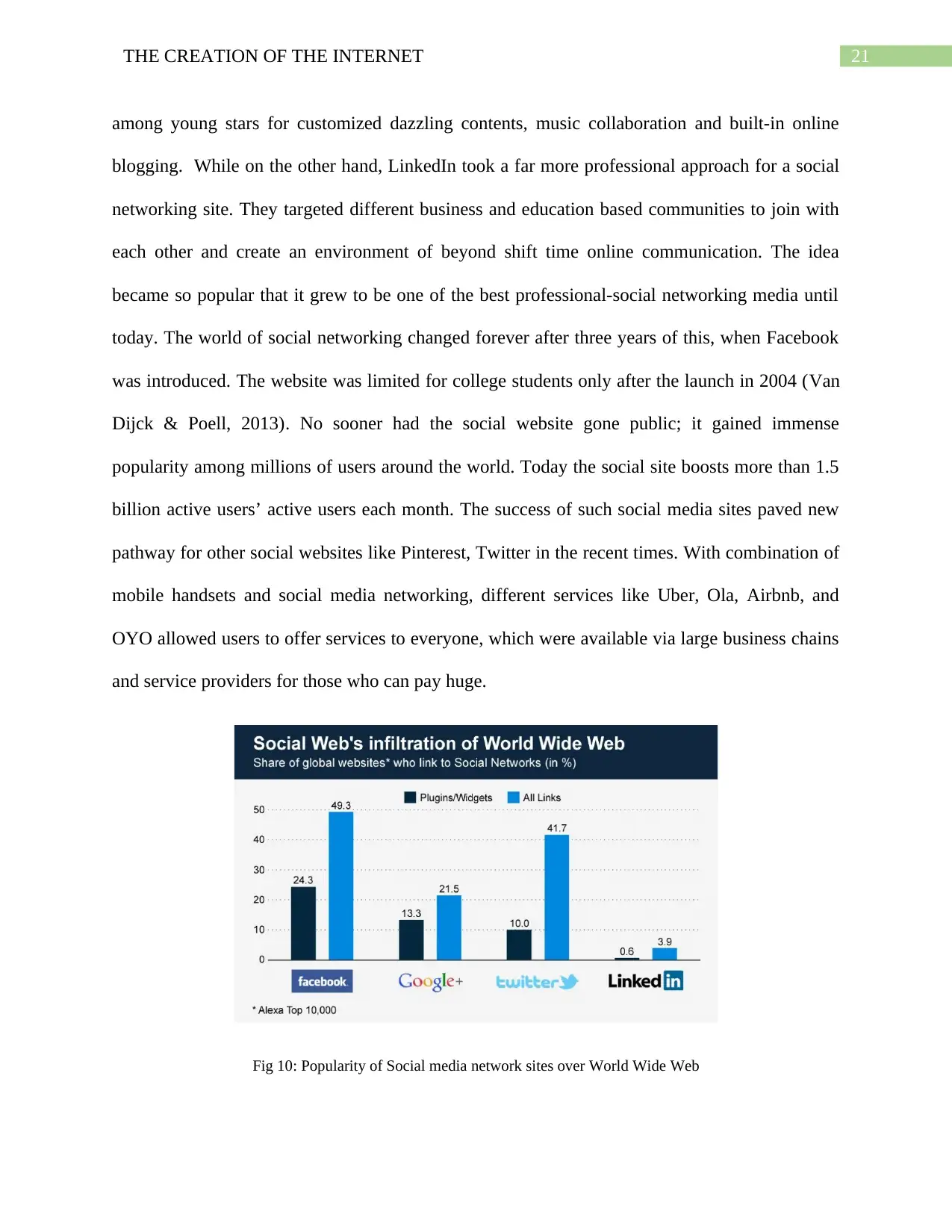
among young stars for customized dazzling contents, music collaboration and built-in online
blogging. While on the other hand, LinkedIn took a far more professional approach for a social
networking site. They targeted different business and education based communities to join with
each other and create an environment of beyond shift time online communication. The idea
became so popular that it grew to be one of the best professional-social networking media until
today. The world of social networking changed forever after three years of this, when Facebook
was introduced. The website was limited for college students only after the launch in 2004 (Van
Dijck & Poell, 2013). No sooner had the social website gone public; it gained immense
popularity among millions of users around the world. Today the social site boosts more than 1.5
billion active users’ active users each month. The success of such social media sites paved new
pathway for other social websites like Pinterest, Twitter in the recent times. With combination of
mobile handsets and social media networking, different services like Uber, Ola, Airbnb, and
OYO allowed users to offer services to everyone, which were available via large business chains
and service providers for those who can pay huge.
Fig 10: Popularity of Social media network sites over World Wide Web
Paraphrase This Document
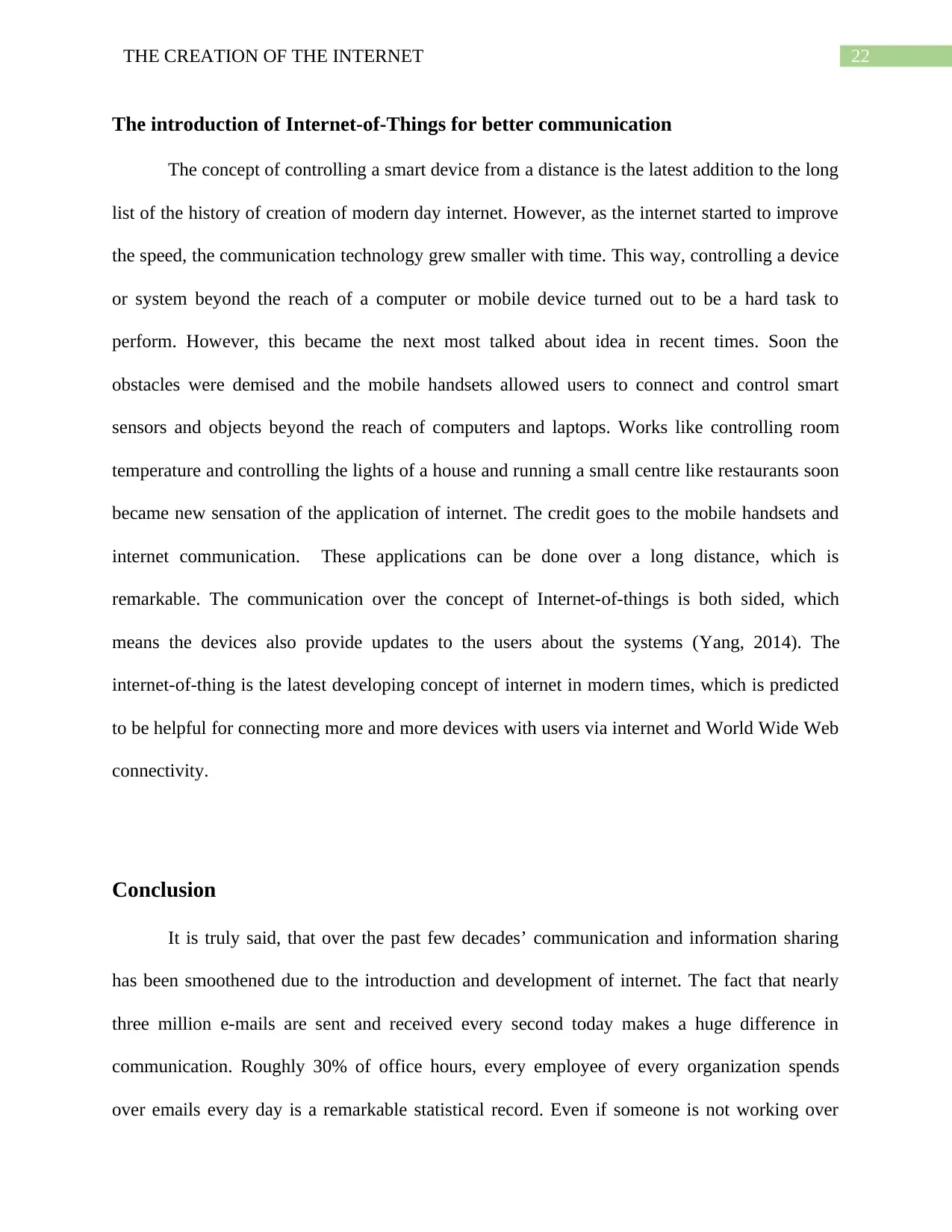
The introduction of Internet-of-Things for better communication
The concept of controlling a smart device from a distance is the latest addition to the long
list of the history of creation of modern day internet. However, as the internet started to improve
the speed, the communication technology grew smaller with time. This way, controlling a device
or system beyond the reach of a computer or mobile device turned out to be a hard task to
perform. However, this became the next most talked about idea in recent times. Soon the
obstacles were demised and the mobile handsets allowed users to connect and control smart
sensors and objects beyond the reach of computers and laptops. Works like controlling room
temperature and controlling the lights of a house and running a small centre like restaurants soon
became new sensation of the application of internet. The credit goes to the mobile handsets and
internet communication. These applications can be done over a long distance, which is
remarkable. The communication over the concept of Internet-of-things is both sided, which
means the devices also provide updates to the users about the systems (Yang, 2014). The
internet-of-thing is the latest developing concept of internet in modern times, which is predicted
to be helpful for connecting more and more devices with users via internet and World Wide Web
connectivity.
Conclusion
It is truly said, that over the past few decades’ communication and information sharing
has been smoothened due to the introduction and development of internet. The fact that nearly
three million e-mails are sent and received every second today makes a huge difference in
communication. Roughly 30% of office hours, every employee of every organization spends
over emails every day is a remarkable statistical record. Even if someone is not working over

internet, he or she is surfing the internet for amusements and communicating with others. This
way everyone is talking over the social media websites. Statistical record shows nearly seven
million people shares information over social media every day. Not a decade ago, people had to
wait for favorite television shows to learn a recipe of food, which is now a task performed within
a blink of an eye. The creation of the internet has revolutionized the idea of fast lifestyle, easy
accessibility of different services and super easy process of knowledge sharing for everyone
around the world.
⊘ This is a preview!⊘
Do you want full access?
Subscribe today to unlock all pages.

Trusted by 1+ million students worldwide
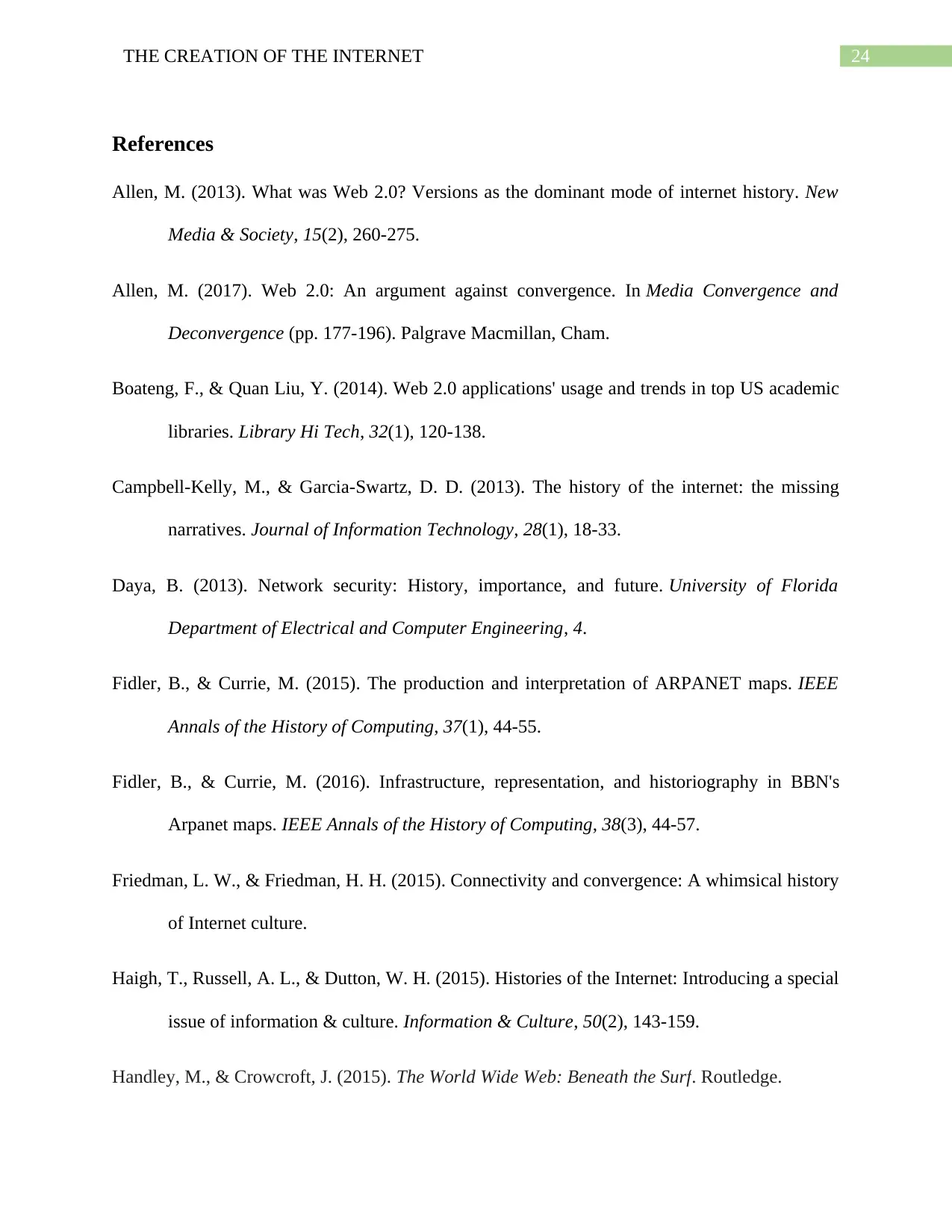
References
Allen, M. (2013). What was Web 2.0? Versions as the dominant mode of internet history. New
Media & Society, 15(2), 260-275.
Allen, M. (2017). Web 2.0: An argument against convergence. In Media Convergence and
Deconvergence (pp. 177-196). Palgrave Macmillan, Cham.
Boateng, F., & Quan Liu, Y. (2014). Web 2.0 applications' usage and trends in top US academic
libraries. Library Hi Tech, 32(1), 120-138.
Campbell-Kelly, M., & Garcia-Swartz, D. D. (2013). The history of the internet: the missing
narratives. Journal of Information Technology, 28(1), 18-33.
Daya, B. (2013). Network security: History, importance, and future. University of Florida
Department of Electrical and Computer Engineering, 4.
Fidler, B., & Currie, M. (2015). The production and interpretation of ARPANET maps. IEEE
Annals of the History of Computing, 37(1), 44-55.
Fidler, B., & Currie, M. (2016). Infrastructure, representation, and historiography in BBN's
Arpanet maps. IEEE Annals of the History of Computing, 38(3), 44-57.
Friedman, L. W., & Friedman, H. H. (2015). Connectivity and convergence: A whimsical history
of Internet culture.
Haigh, T., Russell, A. L., & Dutton, W. H. (2015). Histories of the Internet: Introducing a special
issue of information & culture. Information & Culture, 50(2), 143-159.
Handley, M., & Crowcroft, J. (2015). The World Wide Web: Beneath the Surf. Routledge.
Paraphrase This Document

Kurose, J. (2014). Information-centric networking: The evolution from circuits to packets to
content. Computer Networks, 66, 112-120.
Mohan, C. (2013, March). History repeats itself: sensible and NonsenSQL aspects of the NoSQL
hoopla. In Proceedings of the 16th International Conference on Extending Database
Technology (pp. 11-16). ACM.
NSUDE, I. (2017). An historical analysis of the internet as a modern communication medium
and lts role in globalization. International Journal of Communication, 1(1).
Russell, A. L. (2013). The internet that wasn't. IEEE Spectrum, 50(8), 39-43.
Russell, A. L., & Schafer, V. (2014). In the Shadow of ARPANET and Internet: Louis Pouzin
and the Cyclades Network in the 1970s. Technology and Culture, 55(4), 880-907.
Sajithra, K., & Patil, R. (2013). Social media–history and components. Journal of Business and
Management, 7(1), 69-74.
Strawn, G. (2014). Masterminds of the Arpanet. IT Professional, 16(3), 66-68.
Tanasic, B. R . INTERNET-FROM ARPANET TO THREE BILLION USERS.
Tess, P. A. (2013). The role of social media in higher education classes (real and virtual)–A
literature review. Computers in Human Behavior, 29(5), A60-A68.
Van Dijck, J., & Poell, T. (2013). Understanding social media logic.
Yang, S. H. (2014). Internet of things. In Wireless Sensor Networks (pp. 247-261). Springer,
London
Related Documents
Your All-in-One AI-Powered Toolkit for Academic Success.
+13062052269
info@desklib.com
Available 24*7 on WhatsApp / Email
![[object Object]](/_next/static/media/star-bottom.7253800d.svg)
© 2024 | Zucol Services PVT LTD | All rights reserved.




